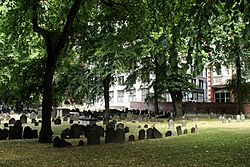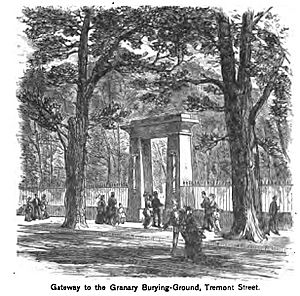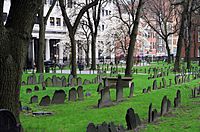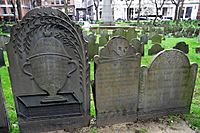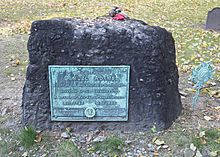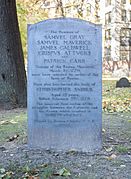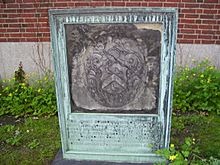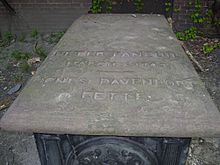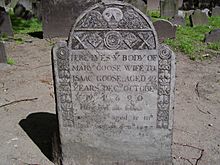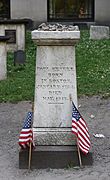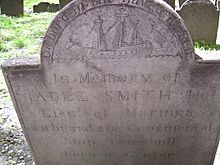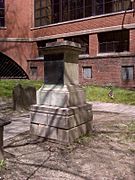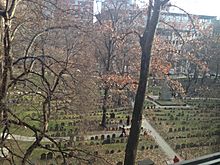Granary Burying Ground facts for kids
The Granary Burying Ground in Massachusetts is Boston's third-oldest cemetery. It was started in 1660 and is located on Tremont Street. This historic cemetery is the final resting place for many important people from the Revolutionary War.
You can find the graves of Paul Revere and the five victims of the Boston Massacre here. Three signers of the Declaration of Independence are also buried here: Samuel Adams, John Hancock, and Robert Treat Paine. The cemetery has 2,345 grave markers. However, historians believe that as many as 5,000 people are buried there. The Granary Burying Ground is next to Park Street Church and is a stop on Boston's famous Freedom Trail.
The cemetery's special gate and fence were designed by architect Isaiah Rogers. They have an Egyptian revival style, which means they look like ancient Egyptian art.
Contents
History of the Granary Burying Ground
The Granary Burying Ground was Boston's third cemetery. It was created in 1660 because the city's first cemetery, King's Chapel Burying Ground, was becoming too small. This new burial ground was first called the South Burying Ground. In 1737, it was renamed after a granary building that stored grain. This building once stood where the Park Street Church is today.
In 1830, trees were planted in the cemetery. There was also an attempt to rename it "Franklin Cemetery" to honor Benjamin Franklin's family. However, this name change did not stick.
The burying ground was originally part of the Boston Common, a large public park. Over time, parts of the common were used for other buildings. Tombs were first placed at the back of the property.
Puritan churches did not use many religious symbols inside their buildings. So, people in Boston used tombstones to show their beliefs about life after death. A popular design was the "Soul Effigy." This was a skull or "death's head" with a wing on each side. It represented the soul flying to heaven.
In 1717, the town decided to make the burying ground bigger. They used part of the road on the eastern side, which is now Tremont Street. In 1720, 15 new tombs were created for Boston families.
Improvements and Discoveries
In 1762, large European elm trees were planted along Tremont Street. This area became known as "Paddock's Mall." Before this, the rest of the cemetery had no trees at all. In 1830, more trees were planted around the grounds.
In 1840, an iron fence was built along Tremont Street. This fence was also designed by Isaiah Rogers. It cost $5,000, with half paid by the city and half by public donations.
In 2009, a hidden crypt was found by accident. A tourist fell through a piece of slate covering a stairway. The stairway led to a crypt that was 8 by 12 feet and still in good shape. It might be the resting place of Jonathan Armitage, a Boston official from the 1700s. The tourist was not hurt.
In 2011, the City of Boston announced a $300,000 project to fix and restore the cemetery. This project included making paths wider and creating new spots for visitors to see the graves.
Memorials and Monuments
One important monument in the Granary Burying Ground is an obelisk built in 1827. This tall, narrow monument honors the parents and relatives of Benjamin Franklin. Franklin himself was born in Boston but is buried in Philadelphia. His father was Josiah Franklin, and his mother was Abiah. The obelisk was made from granite from the Bunker Hill Monument quarry. It replaced the original Franklin family gravestones, which were in bad condition.
The second oldest memorial in the cemetery is near the Franklin monument. It marks the grave of John Wakefield, who died in 1667. The oldest carved stone is for the Neal Children, dating to 1666.
Near the Tremont Street entrance, you can find the graves of the Americans who died in the Boston Massacre. This event happened on March 5, 1770. In the 1800s, the grave markers were moved into straight lines. This was done to make the cemetery look more organized and to make it easier to mow the lawn.
Notable Burials
Many famous people are buried here, including:
- Samuel Adams (1722–1803), a statesman and signer of the Declaration of Independence.
- Crispus Attucks (1723–1770), an African-American victim of the Boston Massacre. He is in a common grave with the other four victims and Christopher Seider.
- James Bowdoin (1726–1790), a well-known merchant and the second Governor of Massachusetts.
- Rev Mather Byles (1706–1788), a famous minister.
- John Endecott (c. 1588–1665), the first Governor of the Massachusetts Bay Colony.
- Peter Faneuil (1700–1743), who gave money to build Faneuil Hall.
- Members of Benjamin Franklin's family. Benjamin Franklin himself is buried in Philadelphia.
- Mary Goose (1665–1758), sometimes said to be the original Mother Goose.
- Jeremiah Gridley (1702–1767), a lawyer.
- John Hancock (1737–1793), a statesman and signer of the Declaration of Independence.
- James Otis Jr. (1725–1783), a lawyer and important figure in the Revolutionary War.
- Robert Treat Paine (1731–1814), a signer of the Declaration of Independence.
- Ebenezer Pemberton (1746–1835), an American educator.
- John Phillips (1770–1823), the first mayor of Boston.
- Wendell Phillips (1811–1884), an American abolitionist and speaker.
- Edward Rawson (1615–1693), the first secretary of the Massachusetts Bay Colony.
- Paul Revere (1735–1818), a silversmith and famous Revolutionary War Patriot.
- Christopher Seider (1758–1770), a boy killed shortly before the Boston Massacre.
- Samuel Sewall (1652–1730), a judge during the Salem Witch Trials.
- John Smibert (1688–1751), a Scottish-American artist.
- Cyprian Southack (1662–1745), a mapmaker and naval commander.
- Increase Sumner (1746–1799), the fifth Governor of Massachusetts.
- Nathan Webb (1705–1772), a minister for over 41 years.
- The owner of Phillis Wheatley (1753–1784), an American slave and the first African-American poet to publish a book. Phillis Wheatley herself is buried elsewhere.
- Benjamin Woodbridge (1708–1728), a victim of the first duel fought in Boston.
Gallery
-
Grave of Samuel Adams.
-
Grave of Crispus Attucks, Christopher Seider, and other victims of the Boston Massacre.
-
James Bowdoin's tomb.
-
John Hancock memorial.
-
James Otis' grave.
-
Paul Revere memorial.
-
Grave of John Wheatley, owner of Phillis Wheatley.
See also
- Central Burying Ground
- Copp's Hill Burying Ground
- Funerary art in Puritan New England
- King's Chapel Burying Ground
- List of cemeteries in Boston, Massachusetts


